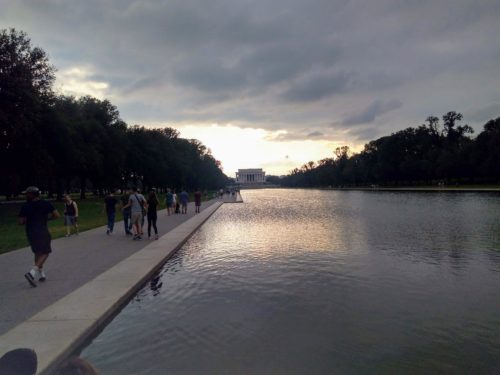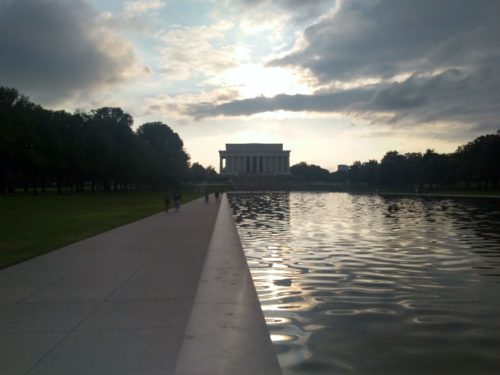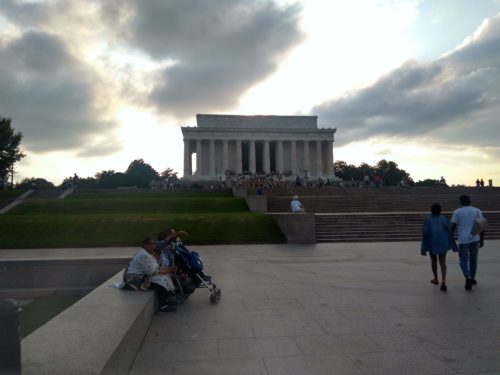Pagan Perspectives
It strikes me that I ought not to be making this walk upright. Pilgrims on their journey to see the Shroud of Our Lady of Guadalupe in Mexico City are known for crawling on their hands and knees as they approach the basilica where the Shroud is kept; my father told me that when he visited, he saw a line of prostrated devotees starting miles from the church. There are no such pilgrims here, but it seems that there could be. The stones upon which I walk are perhaps among the most sanctified in the secular religion of American civic life; certainly no single mile of soil in the United States has been more consciously constructed as a pilgrim’s road.

[E. Scott]
A young man with dark skin in a white polo walks up to me and looks at the monument. “Is it open?” he asks. I point out a sign on the lawn: closed for indefinite repairs. Something about the elevator. “Sorry, friend,” I say. He thanks me and walks off, leaving me alone.
Across the grass in one direction lay the Smithsonian, and beyond that, the United States Capitol; in the other direction, the Roman temple erected for Lincoln. I thought about it for a moment. All the museums had already closed, and anyway, I had no desire to look at the Houses of Congress, so I started walking to the west.
The path between the memorials to Washington and Lincoln leads through a forest of monuments: from the great obelisk dedicated to the United States’ first president, the road passes through a fountain erected in honor of those who fought in World War II, and on either side the path is flanked by monuments dedicated to soldiers sent overseas to fight, die, and kill in the wars for Korea and Vietnam. Those monuments are hidden by trees, though; nobody sees them unless they go looking for them. The most straightforward path follows the edge of the Reflecting Pool, the long stone pond whose image has been caught in a million photographs. Today, the pool reflects a gray sky that sometimes flares with light from the setting sun.
One finds few landmarks alongside the Reflecting Pool, which means that the view appears to remain consistent all along its length: it’s all one long line of water and stone with the memorial off in the distance. Every so often I look up and realize how much larger the memorial has grown in my sight as I have gotten closer. Like an optical illusion, every time I think I have figured out just how big the Lincoln Memorial is, it turns out to be bigger.

[E. Scott.]
“What building is this?” the woman asks me, pointing to the memorial.
“It’s the Lincoln Memorial,” I say. “He was president during our civil war.”
They nod and keep walking, and I find myself wondering at the inadequacy of my description.
At the steps of the memorial there is a crowd of tourists and the various hucksters who earn their livings by plying said tourists with knickknacks, ice chests full of Aquafina, and puppet shows featuring dead men with names like Monroe and Jackson rendered in felt. As I move through them and begin to climb the stairs up to the sanctuary hidden in the shadows of the columns, the thought of a penitent crawl again crosses my mind, but, preferring not to make a scene, I opt simply to kneel on the first and last steps of each landing, like a penitent entering the pews of a church.
One might ask, why such reverence? Indeed, I ask myself the same question. I have, more and more in the past few years, grown to reject models of history that lay much blame or credit to “great men.” The idea that Abraham Lincoln freed the slaves is preposterous – or at least, the idea that he did it single-handedly and solely of his own conscience is. At the most limited and legalistic perspective, the passage of the 13th amendment (itself hardly a perfect piece of legislation, to which any of the participants in the current national prison strike might testify) still required an immense amount of politicking in order to be ratified; at the most broad and honest perspective, the end of slavery required centuries of resistance by African-Americans and their abolitionist allies, and the blood of more than a million soldiers and civilians. It is not a story of any one “great emancipator.”
Inside the sanctuary, where the famous statue of Lincoln sits awaiting the next round of visitors eager for selfies with Honest Abe, there are two quotes engraved in the walls. On the left wall is the Gettysburg Address, that “four score and seven years ago” message about the preservation of the union that every elementary school child in America is made to recite. On the right is the second inaugural address, a text less familiar than Gettysburg, but to my mind by far the more important:
The Almighty has His own purposes. “Woe unto the world because of offenses; for it must needs be that offenses come, but woe to that man by whom the offense cometh.” If we shall suppose that American slavery is one of those offenses which, in the providence of God, must needs come, but which, having continued through His appointed time, He now wills to remove, and that He gives to both North and South this terrible war as the woe due to those by whom the offense came, shall we discern therein any departure from those divine attributes which the believers in a living God always ascribe to Him? Fondly do we hope, fervently do we pray, that this mighty scourge of war may speedily pass away. Yet, if God wills that it continue until all the wealth piled by the bondsman’s two hundred and fifty years of unrequited toil shall be sunk, and until every drop of blood drawn with the lash shall be paid by another drawn with the sword, as was said three thousand years ago, so still it must be said “the judgments of the Lord are true and righteous altogether.”
The god Lincoln describes is not my god, and the sense of moral justice communicated here does not match with the precepts of my Paganism; and yet these words are enough to bring me to tears. America was founded on two great crimes, the genocide of the land’s indigenous peoples and the importation and enslavement of African-Americans, and neither of those crimes has yet seen a full restitution. Yet to say there has not been a full restitution is not to say that there has been no restitution at all. The blood of the lash and the blood of the sword that Lincoln describes do deserve veneration. Would that we held such dedication today to redeeming the blood spilled in the name of our modern oppressions.

[E. Scott.]
Still, I find myself quieted by the presence of the holy. Not Lincoln himself, really, except perhaps as a synecdoche for the rest of the struggle. He is the secular American saint, down to his martyrdom and his subsequent hagiography, but what he represents is really the time in which one of the great evils of the country was, if not entirely abolished, at least greatly diminished. The struggle is what’s sacred. As imperfect a vessel as this statue of a long-dead president might be, I still find that sacredness suffuses the air in this secular temple.
As I walk out, back into the orange light of the setting sun, I see my friend in the white polo shirt from the Washington Monument standing on the portico. We say hello again, neither of us quite eager to start trekking back toward downtown.
“Can I ask you something?” I say.
“Sure,” he says.
“This place, the memorial. How does it make you feel?”
He thinks for a minute, scratches his head. “Hopeful, I think.”
“What do you mean?”
“It’s like…” He looks at me, his eyes deep and brown, and continues. “It reminds me of everything that we had to go through to get to this point, you know? Everything people sacrificed. How far we’ve come. How far we’ve got to go.”
We look out together toward the Washington Monument. It seems to me as though the long pool before us stands for the century between the American Revolution and the Civil War, for the time when a nation that told itself that it was founded on life and liberty built itself on enslaved black labor. I wonder what, someday, might lay that much farther to our west.
* * *
The views and opinions expressed by our diverse panel of columnists and guest writers represent the many diverging perspectives held within the global Pagan, Heathen and polytheist communities, but do not necessarily reflect the views of The Wild Hunt Inc. or its management.
The Wild Hunt is not responsible for links to external content.
To join a conversation on this post:
Visit our The Wild Hunt subreddit! Point your favorite browser to https://www.reddit.com/r/The_Wild_Hunt_News/, then click “JOIN”. Make sure to click the bell, too, to be notified of new articles posted to our subreddit.